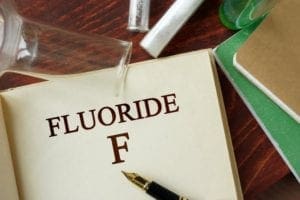Some Simple Chemistry
Ken Perrott, retired research scientist, explains in simple terms how fluoride interacts with water.
More Advanced: Hydrolysis Reaction of Fluoridation Substances
 In aquatic chemistry, there are many ions that interact with the water molecules. Water is polar, which means that one side of the water molecule is positive (the hydrogen side where both hydrogens group in order to share their electrons) and the other side is negative (the oxygen side). When other ions are added to water, such as Hydrogen, Silica, and Fluoride as is the case with fluorosilicic acid, they will associate with the polar water molecules aligning with their own electrical charges.
In aquatic chemistry, there are many ions that interact with the water molecules. Water is polar, which means that one side of the water molecule is positive (the hydrogen side where both hydrogens group in order to share their electrons) and the other side is negative (the oxygen side). When other ions are added to water, such as Hydrogen, Silica, and Fluoride as is the case with fluorosilicic acid, they will associate with the polar water molecules aligning with their own electrical charges.
When fluorosilicic acid is added to result in 0.7 mg/L of fluoride content, you are adding six fluoride ions and two hydrogen ions. So there is actually little hydrogen being added.
Drinking water is not “pure” water but contains many ions. Natural waters will leach ions from rocks and soils to satisfy water molecule polarity for electrical stability that results from the polar nature of water. This often results in much calcium and silica to be dissolved in the water, along with many other ions. Most natural waters will have between 50 to 500 mg/L of those other ions dissolved. The nature and type of ions in waters result in natural waters having varying levels of corrosiveness. In order to ensure that the water meets the Lead-Copper Rule requirements by EPA, water utilities will evaluate the level of natural corrosiveness and adjust the hardness of the water which is addition of divalent ions such as calcium.
The amount of divalent ions such as calcium along with silica content and phosphates can provide a buffering of the water’s pH. So when you add a small amount of hydrogen ions to the water, they will associate with the divalent ions such as calcium and the pH is buffered. You need to add a considerable amount of acid to consume that buffering and the small amount added by fluoride simply does not come close. Most water treatment facilities will add on the order of 50 to 100 mg/L of acids and bases for flocculants, disinfectants, oxidants, and water buffering agents. Compare that to the 0.7 mg/L of fluoride being added for oral health, and you realize it is roughly two orders of magnitude difference.
Also, since water utilities need to add buffering agents to the water, they calculate how much they need to add based on natural corrosivity, along with the other water treatment additives, so although the fluoride additive only represents perhaps 1 to 5% of the acidity, that will be included in the calculation.
There are some very rare cases where a groundwater with extremely soft water (having exceptionally low calcium, which is quite rare) where the addition of fluoride can result in a pH drop of 0.1 pH unit, or if the natural water is pH 7.2 and you add fluoride it will drop to pH 7.1. In these rare cases the water system must still test for Lead-Copper corrosivity and if it measured as prone to leaching, then they must add a buffering agent.
